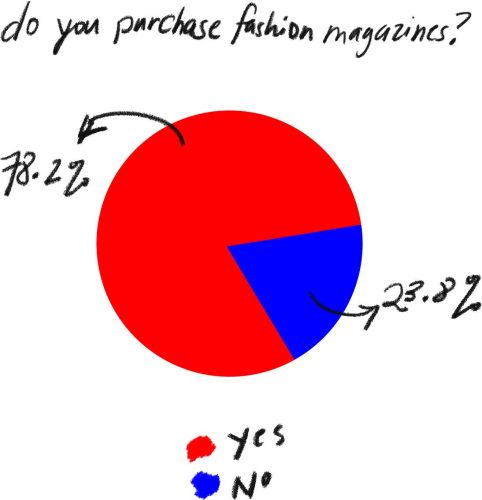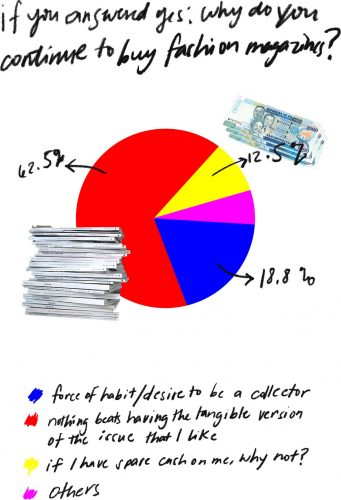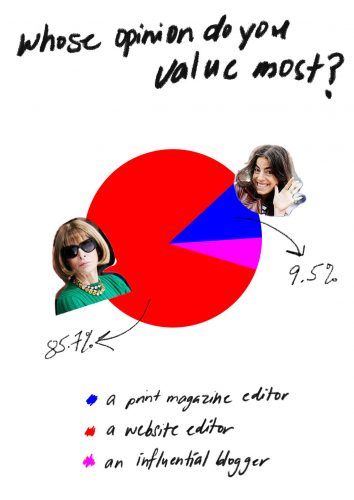Is it really dead, anyway? Or is a coma more like it?
Is print media dying?
This is the question that continues to shake and divide the world of publishing. To this day, too, publishers continue to argue that the tangibility of the print magazine will forever be its unbeatable edge. A sweeping statement, true, but one that’s backed by studies that prove people understand and retain information better when they consume content printed on paper rather than via an electronic device. Others, however, let lifestyle trends speak for themselves: The recent decade saw the triumph of desktops, tablets, smartphones and social media. Along with this, the dwindling demand for print.
While there is no consensus regarding the definitive fate of print media, it is clear that the World Wide Web not only changed the game, but sped up its pace: allowing more participants to join the race and leaving some long-established contenders behind in the running both here and abroad.
For one, the fashion industry as a whole, which thrived in large part thanks to print, now faces a serious dilemma. How do they position themselves in a world ruled by new media that heroes page views and page loading speed, follower count and number of shares over quality of content?
The Evolution of Communication
In 2015, two-thirds of the world population had access to the internet. Research found that 68% of the adults in this group had smartphones at their disposal. Today, city dwellers are able to check their mail, catch the news, stream videos and reach people in their circles quicker via social media––and all at once. The digital age paved the way for a paperless lifestyle, too, ultimately transforming the way people consume content.
“[Thirty-three] years ago, the internet was only three years old itself,” explains tech writer, Scott Bradner in an in-depth retelling of the history of the internet. “At that time, less than 2,500 hosts were connected to the internet and maybe 10,000 people used it regularly. Now, there are more than 800 million hosts and 1.8 billion regular users.”
RELATED: Pinoy Culture: Why Do We Smart Shame?
Print Then and Now
Originally made available on newsstands, in bookstores, at mall kiosks and by subscription, glossy fashion magazines were the cream of the crop in print, straightforward in their extravagance and highly regarded. With the introduction of digital media, though, these print publications were met with new and more modern leads as to how they can—and should—reach loyal and prospective readers. Since then, the magazine industry has ceased to be a uniform business.
2016 saw the end of several print brands such as InStyle UK and Cleo. Self Magazine also shut down as circulation dropped to less than 1.5 million and sales of per-issue purchases dipped from 148,055 in 2014 to 44,000 in the first half of 2016. Amid disrupted operations, larger publishing houses have opted to scale back on production of print. Teen Vogue, for example, reduced its number of print issues to four per year in 2017 and beefed up its web counterpart teenvogue.com. The Condé Nast brand would decide to ditch print altogether only a year later.
For publishers, this means tasks now include supplementing less frequently produced print issues with digital and social content. In the case of New York Magazine, which encountered a 9.2% decline in ad pages in 2013 but saw nine million unique visitors a month on their website, this spurred an all-new media strategy: to cut the number of New York Magazine print staff members and to integrate the official website’s most popular segment, The Cut, into the redesigned magazine.
Regardless of strategy, for several larger companies, folding altogether is not an option.
Focusing on Quality Print Material
Local publishing houses are following in the footsteps of international arbiters like Hearst and Condé Nast: adapting by redesigning.
With the intention of sparking new interest in readers, they now invest in improving upon factors they have control over like cover designs, paper quality and page layouts. The end-goal, almost, is to produce issues so artfully constructed that they appear curated enough to take the place of a coffee table book in lieu of merely being filed away in a bookshelf: the curation of a gratifying journey, in other words, from cover to cover. Digital editor Gary Thompson, in his 2013 op-ed for The Independent, illustrated this superiority of printed material when he pointed out: “The great thing about [print] is that it’s a finite journey. When you finish turning the pages, you’ve ‘read the paper.’ You’re satisfied that you’ve consumed something and it’s reassuring to know that you’re in the know. Reading a website isn’t like that. It’s an abstract journey without an end—like one of those cheap buffet meals offering endless choice, but which never actually fills you up.”
Readership is Dwindling, But Prestige Remains
For a crop of 63 Millennials, who find themselves on the cusp of the traditional-to-digital shift, traditional print magazines (namely, fashion) still exhibit superiority in more ways than one.
To start, 48 out of the 63 men and women surveyed by Wonder continue to purchase fashion magazines, albeit not as often. Those who no longer buy magazines, on the other hand, say there is no point in spending money on something they can find on the internet.
Still, when the tangible print mag is put side by side with digital, there is no denying that the former is regarded as a premium item. Print media, while part of a dwindling industry, is still highly honored, to which the readily available World Wide Web does not hold a candle to in the prestige arena. “Print is still the standard,” quipped one Millennial who answered the survey. “Print is just more legit,” said another. “There is something ceremonial and personal about tucking a magazine you selected yourself in your bookshelf. On the web, you open tabs and then bookmark them if they’re important enough to you. It’s mechanical. There’s nothing special about it.”
Perception Versus Reality Versus Numbers
When readers purchase a print magazine, there exists an understanding that the pages bound together—the value-adding reading material now gloriously secured in their hands—are a carefully put-together compilation of stories told by the experts. An advantage of the exclusivist facet of fashion, it is implied in the world of the glossies that the names typed next to titles under the magazine’s masthead are the industry’s chosen ones: titles earned and not just given, people whose editorial eye had been trained for months up to years, authority paired with expertise.
This perception equals reality, up to a point, which goes to show magazine sales don’t solely keep print brands going here in the Philippines and anywhere else with a bustling fashion industry. Brand equity plays an enormous role. Print’s investment in branding and its cultivated perception of “exceptional” has its rewards. Back to the survey of Millennials, a whopping 85.7% said they trust print magazine editors more than media website editors or influential bloggers.
“Sales aren’t nearly as important to the print brand as the branding scheme is,” shares one former One Mega Group, Inc. art director, Mark Arquilla. “Magazines don’t have to live off its circulation.” Having dealt with both print and digital magazines, Arquilla further draws contrasts, saying: “In print, there is no definite reach that editors have to chase after. It’s in digital, when you look at the back-end, where you see that it’s not a perception game, but a numbers game.”
RELATED: Why Do Some Think That People in Fashion Are Stupid or Shallow?
Digital Means Expansion for a Print Brand, Not Its Obliteration
For print editors like Mega Magazine’s Jebby Fronda, the dot-com platform is seen as a way of leveraging relationships with advertisers, old and new alike, through new executions. The migration, then, is overall a positive movement, although a difficult one. “The strategy for print brands today is to keep up and be savvy with updates especially on social media,” she says. “But as far as Mega goes, we editors only really have to focus on our content. Then comes the promotion of what we produce as print, again, on social media. We aren’t trying to be digital anyway; we just have a digital channel.”
For those on the receiving end, however, opinions are divided almost equally when it comes to talks about print coping with content creation in the digital age. When asked if they feel that local print fashion magazines have lost their touch, 30 answered yes, while 33 said no. “It’s crucial that while print magazines feel ‘regular scheduled programming’ will do, their content must also evolve,” one avid magazine reader said after taking the survey. In relation to this, almost 50% of survey takers said print magazines need to adapt a fresher, more globally appealing take on branding, while 28.6% suggested more youthful editorial content in order to stay current. Finally, 19% said print magazines should branch out on topics and address pressing social issues: less fluff, more bite.
RELATED: The 9 to 6: A Day In The Life of Fashion Editor Jebby Fronda
Print Media Isn’t Dying, But Resting
In the meantime, print and digital media must learn to coexist. “It’s important to keep [our] print magazine, but also to move forward with digital,” adds Fronda.“We want print to complement digital and vice versa. It has to be mutualism where both channels succeed.”
Indeed, those belonging to the print industry are better off seeing the rise of digital as an opportunity to broaden horizons and reconnect with a different side of their readers (rather than see it as the end of their era)…and, well, to stop digital as the enemy or “the ugly cousin of print.”
RELATED: New Year, New Hobby: 5 Creative Things to Try Out This Year
Art Alexandra Lara





















